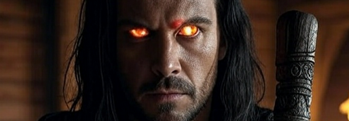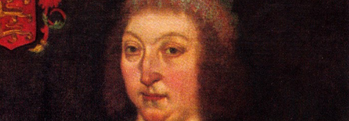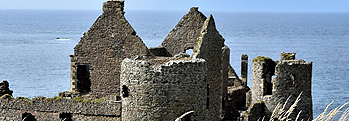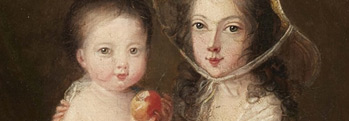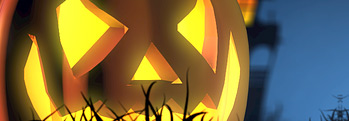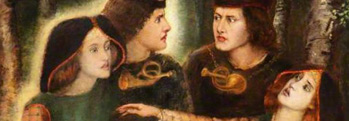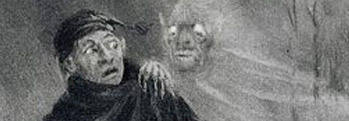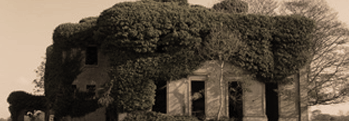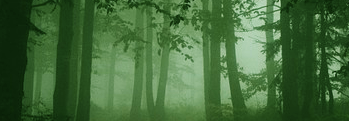Black Alice
Irish and Celtic myths and legends, Irish folklore and Irish fairy tales and Irish Ghost Stories
Marry in haste, repent at leisure, but sometimes you don't even get that much!
 It was the year 1280 in Kyteler's House in Kilkenny that Dame Alice Kyteler was born to a family of good prospects, a family of Flemish merchants who had settled in Kilkenny. When she grew up, Alice married William Outlawe, a wealthy merchant and moneylender, by whom she had a son. Then she married to her second husband, Adam le Blund of Callan, another rich moneylender. When he died, Alice married her third husband, Richard de Valle, a wealthy landowner, and after that, she married Sir John le Poer, who also died.
It was the year 1280 in Kyteler's House in Kilkenny that Dame Alice Kyteler was born to a family of good prospects, a family of Flemish merchants who had settled in Kilkenny. When she grew up, Alice married William Outlawe, a wealthy merchant and moneylender, by whom she had a son. Then she married to her second husband, Adam le Blund of Callan, another rich moneylender. When he died, Alice married her third husband, Richard de Valle, a wealthy landowner, and after that, she married Sir John le Poer, who also died.
She became known as Kilkenny's merry widow, and her good fortune seemed to have no end, whatever about those of her spouses!
After this fourth sudden and mysterious death, where her former husband was found with his nails torn out and body hair fallen off, not to mention his will changed to benefit Alice and her son, the children of her husbands got together and accused her of witchcraft!
Seven were the charges brought against her and her servants – that she denied Christ and the teachings of the Church, that she had intercourse with a demon called the son of Art in exchange for sorcerous powers, that they cut up living animals and scattered the pieces in unhallowed places as offerings to pagan gods, that they stole the keys to a church and held meetings there at night, that they made love potions and poisons from vile ingredients in the skull of a hanged robber, and that Alice had used these potions to make her husbands give their possessions to her son, and finally, to kill them.
They went to the Bishop of Ossory with their complaint, and he convened a court to hear them and conduct a trial. The Bishop was a Franciscan, Richard de Lederer, and beside him stood five knights and several noblemen. And yet for all of his authority, the Bishop not only failed to get Alice to appear before him, but wound up in prison himself!
She eventually escaped to England, never to be heard of again, but her son stood trial and was convicted of witchcraft, being ordered to attend mass thrice a day and give of his considerable wealth to the poor at the behest of his powerful friends. He didn't manage to maintain the penance however and ended up in prison again until he prostrated himself before the Bishop and was ordered to cover the roof of the local cathedral with lead. He did succeed in this penance, but the roof of the cathedral collapsed under the weight of the lead a few years later.
Less fortunate was her maid Petronella, who was tortured, whipped, and finally burned at the stake.
And yet before she died, legend has it that Petronella swore to take her revenge on the crowds of gawpers, and then she was consigned to the flames.
Ever since then, strange goings-on have been recorded in and around Kilkenny, and tales of ghostly apparitions have multiplied, especially around the time of 1763, when a great flood came to Kilkenny, and a hundred people stood on the nearby John's bridge watching debris flow by beneath. But when most of them got off to view a cabin floating by, the bridge collapsed, killing sixteen, and still to this day people speak of ghostly figures leaning over the side of the bridge, watching the water!
The site of Kyteler's house is marked on the map below.
More Irish Ghost Stories
Mongán mac Fíachnai was a prince of the Gaels, none other than he whose father was Fíachnae mac Báetáin, and it was about the seventh century in Ireland when he ruled over Ulster. Many are the tales told of him and his royal reign, with some even whispering that he was the son of Manannán mac Lir, ancient G ... [more]
There once was a woman called Máire Rua, or Red Mary, since she was one of the McMahons and had hair like a fiery sunset with a temper to match! Many legends have grown up around this seventeenth century force of nature, some true, some maybe less so, and some she spread herself! She made her seat in Leamanagh Castle, in the Burren in Cou ... [more]
If Dublin is the capital city of Ireland, County Clare is its dark reflection on the other side of the country, a place where many of the shadowy tales and unsolved mysteries of bygone years eventually seem to flow. Layer upon layer of centuries burden its rocky hills, left behind by the passage of numberless and nameless peoples, each hiding their ... [more]
Little remains now of once-proud Dunluce castle, whose halls had echoed with the sounds of laughter and music, and whose vaulted arches had defied the most ferocious storms. Only echoes and shadows are left behind, and some say, the tormented ghost of a young lady waiting for her love to return! The castle had originally been built by Richard &O ... [more]
The tale of Kilmagoura in County Cork is, for the most part, a peaceful and quiet one, as it lay under the power of the Fitzgeralds for many years, and they were, for the most part, just and fair rulers. So good were they that nobody had anything bad to say about them, and tales were told of their heroism and generosity. But as they say, it is t ... [more]
The long shadow of Leap Castle in County Offaly stretches across many centuries, and from its dark depths echo tales of terror, murder and the dread hand of the supernatural reaching from beyond the grave! The land upon which the O'Bannon clan built Leap Castle in the thirteenth century was not unoccupied – in fact, it had been used by ... [more]
Once upon a time in Tyrone there were two little children, the son and daughter of parents who had died when they were little. They missed their parents very much, but they were raised by a guardian who was a fanatical atheist, and was determined to convert the children to his beliefs. But they would have none of it, and so they made a childhood ... [more]
Every year around Halloween, people carve pumpkins or turnips into faces and put candles inside them, but not many know that this custom came from Ireland originally, or the story behind it! They say there was a blacksmith many years gone who was fond of his drink, and a mean drunk he was too, and tight with it. Not many friends did stingy Jack ... [more]
There was a famous beauty who lived in Belvelly castle overlooking Cork Harbour in the seventeenth century, and word of her ethereal comeliness spread far and wide. It reached the ears of a local lord by the name of Clon Rockenby, and he declared he must have her for his wife. Her name was Lady Margaret Hodnett, and although she was quite fond o ... [more]
The Redmonds were a comfortably well off family living in Court street in Enniscorthy back in 1910, and they supplemented their income by renting out rooms in their house to lodgers. However, their quiet life was soon to be interrupted by a sinister guest they hadn't invited in! In July of that year they had rented out the room above the kit ... [more]
It was the year 1280 in Kyteler's House in Kilkenny that Dame Alice Kyteler was born to a family of good prospects, a family of Flemish merchants who had settled in Kilkenny. When she grew up, Alice married William Outlawe, a wealthy merchant and moneylender, by whom she had a son. Then she married to her second husband, Adam le Blund of Callan ... [more]
One of the oldest legends in Ireland is that of the Fetch, the ghost of the living, which some say comes down from the ancient Irish word for seer or prophet, fáith. It is a double-spirit, one which takes on the identical appearance of someone as an omen of their impending death, if seen in the evening, or as a promise of good fortune if see ... [more]
They do say Irish people are fond of a good chat, the gift of the gab as it's called, but it seems even Irish ghosts are likewise inclined, as the strange tale of Corney the phantom reveals! Many years ago in Dublin city, a young family moved into a fine residence in the heart of Dublin city. Well-to-do and respectable, they made their new h ... [more]
In the south of the country, from Cork to Waterford, parents often scold wilful children with the warning – behave or Petticoat Loose will get you! And a wise child will do as they are told, for there are few more chilling tales than those of Petticoat Loose. Patrick Flynn's wife was in her labour pains near Ballingeary on a cold night ... [more]
High on a windswept slope in the Wicklow mountains near the summit of Mount Pelier, with a commanding view overlooking Dublin city, lies the burnt and blackened shell of a sinister old hunting lodge, now called the Hellfire Club, and well named it was too! For it was home to the Irish branch of that selfsame society, notorious for drunken debaucher ... [more]
William Phibbs was a well-to-do landlord of the English nobility who decided to develop his considerable estates in Ireland, building a house for himself overlooking the beautiful Ballisodare Bay in Sligo back in 1798. It would be a fine place to enjoy the sunset over Atlantic waters, he decided, and his son used it so. His grandson, also named Wil ... [more]
The old house in Coonen is much spoken of even today, its dark legend stretching back into the mists of time. Some say it is a ghost living there, others say a devil, but rumours go back further into the darkness of elder years, to the old gods of Ireland and the dark rites that were celebrated in their name. The house in Cooneen first entered t ... [more]
The headless horseman is a very ancient tale of Ireland, stretching back to the days before Christ came with St Patrick, when a dark king used to sacrifice people to old black one-eye, Crom Cruach, by decapitation. That very same Crom Dubh, the worm god, who consumed the Druid Prince Cesard in green bubbling acid at the battle of Moy Tura after his ... [more]




